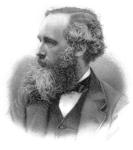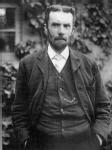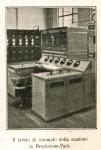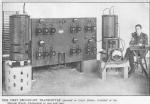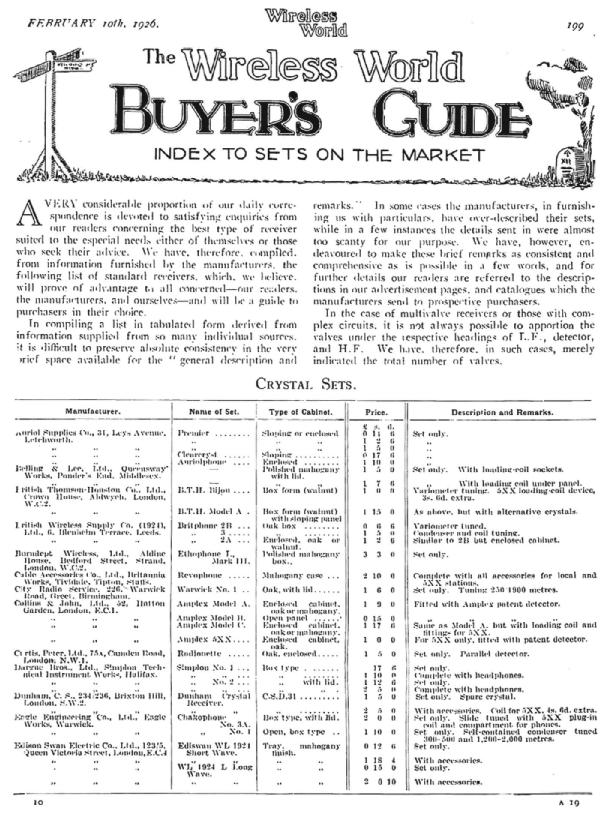
Information / Radiohistory for Great Britain (UK)

British Radio History from "Radis von gestern" (Radios of Yesterday) by Ernst Erb (1989).
A translation by Gary Cowans, Australia.
Early Days of Radio in Great Britain
Marconi's ventures
In 1919, Marconi built a 2.5 kW telephone station in Ballybunion, Ireland. The first European voice heard in America (Louisbourg, Canada) on the 3000 m wave was that of W.T. Ditcham, the station's engineer. Marconi then built in Chelmsford a telephone station (MZX) with 6 kW of power, which went into operation in January 1920. From February 23rd, 1920, he increased the output to 15 kW and started broadcasting a regular program of news, music, and entertainment. Ship operators also listened in on the Poldhu frequency (2800 m). In June 1920, the Daily Mail newspaper donated a thousand pounds to have the famous Australian soprano singer Nellie Melba appear on Radio Chelmsford on June 15, 2020. The newspaper heavily promoted this event. Nellie Melba's voice could be heard in Paris, Rome, Warsaw, Madrid, Berlin, Stockholm, and Tabriz in Persia—to name just the most important cities. Many people are now starting to become interested in receiving equipment; A national radio industry for civilian needs is created.
Amateur Radio
It has been proven that there have been radio amateurs in Great Britain since 1898. They received their first broadcasting licenses in 1905. During World War I, the state revoked the licenses. From August 20th, 1920, radio amateurs were allowed to broadcast telephony again on waves of 1000 m with a maximum of 10 watts. The Press Association expanded its news service in the same month, installing tube receivers in its Newcastle, Preston, Sheffield, and Belfast offices. These used "R" tubes and worked with loop antennas. In the same year, Croydon Airport switched to telephony with its Marconi transmitter. At 900 m, radio owners could receive the crew's conversations during the flight to Paris. On November 23rd, 1920, the postal service withdrew the license of the Chelmsford station because it was allegedly disrupting its traffic—with spark transmitters—to Cairo, India, and America on wave 12,200 m! The relationship was probably the opposite.
Repeal of the 1914 Law
As of September 21, 1921, everyone could freely make or buy devices due to the repeal of a law from 1914. The commissioning of a device requires registration. So-called "toy devices"—receivers and transmitters whose performance is so limited that the range remains less than 55 m—can be installed completely freely. Continuing restrictions on amateur traffic prompted the Wireless Society of London to send the Post a detailed petition signed by 65 clubs on 12/29/21. On 1/25/22, the Post Office allowed a subsidiary of Marconi's Wireless Telegraph Co. Ltd. to broadcast a weekly entertainment program, etc., from station 2MT in Writtle, Essex. The subsidiary was created on November 1, 1919, with the name Marconi Scientific Instrument Co. Ltd. It produces, among other things, amateur devices (radio receivers). In January 1922, she and other companies showed numerous devices for private use at the Model Engineer Exhibition in London. The six other companies are: G.Z. Auckland & Sons, Bower & Co., Burnham & Co., Economic Electric Co., A.W. Gamage, and F.O. Read & Co.
Station 2MT
Station 2MT began a regular Tuesday broadcast on February 14, 1922; only half an hour of music at 700 m with an output of 250 watts was permitted. Wireless World reported on the event a week earlier, and the station could still be heard in Scotland. Due to a lot of interference from the ship's radio, a frequency change to 400 m occurred in May. The post office declared the band from 350-425 m to be the "broadcasting band."
The Metropolitan-Vickers Electrical Company, which pools its patents with the Radio Communication Company (RCC), can also broadcast test broadcasts in Manchester. The RCC is broadcasting from Slough on a trial basis. From May 11, 1922, the 2LO transmitter in the Marconi House broadcast radio broadcasts with 100 watts of power on a wavelength of 360 m. He and the RCC station broadcast the Carpentier-Lewis boxing match; Carpentier wins after just one minute. All of these events led to the first of a long series of meetings between the Post and interested parties on 18 May 1922. The goal is a definitive broadcast network. A strange but successful solution is reached (see below in the text) in cooperation with the authorities. Thanks to this, there is an above-average increase in listeners, devices, and the quality of programs in Great Britain. BBC programs are still considered the best today.
In the summer of 1922, station 2LO began broadcasting at 1.5 kW and expanded its program. There are now around 11,000 reception licenses. The International Radio Exhibition opens in Central Hall, Westminster, from September 2nd to 8th, 2022. Around 40 domestic and foreign companies are exhibiting. From September 30th to October 7th, 52 British manufacturers will present their products to the public at the Horticultural Hall, London SW1. Both exhibitions were an overwhelming success for the public. At the beginning of October 1922, the Western Electric Company was allowed to operate a 500-watt system in London. At the end of October, she will move the station to Birmingham. She will be broadcasting from November 15th, under BBC as 5IT, from the premises of the General Electric Company.
BBC
The Postmaster General wants to avoid chaotic conditions like in the USA, where there is now a cramped situation due to too many stations on a limited broadcast band. It aims for a single organization supported by many to take responsibility for public broadcasting.
On October 18, 2022, the radio industry companies founded under the leadership of the six largest (Marconi's Wireless Telegraph Co. Ltd., Radio Communication Co. Ltd., British Thomson-Houston Co. Ltd. (BTH), General Electric Co. Ltd., Metropolitan -Vickers Electrical Co. Ltd. and Western Electric Co. Ltd.) the British Broadcasting Co. (BBC). The capital is 100,000 pounds; the companies subscribe 60% equally. The founders also plan for each listener to subscribe to one share. The company aims to set up radio stations and distribute radio sets built by member companies. It was allowed to begin test shipments from November 1, 1922, although it did not appear in the commercial register until December 15, 2022. The BBC has high goals for the design of its programs. The costs of the broadcasting stations can be covered by half, and from 1924 onwards, three-quarters of the listener fees and a ten percent sales tax from the members.
At the end of April 1923, 260 manufacturers were represented with 1,450 types of equipment. The company notes that parts and devices for approximately 300,000 recipients were sold, but only 80,000 licenses exist. The BBC wants postal authorities to impose stiff penalties on "shaft theft". In [158] it says: "According to an official announcement from the English chief telegraph director, at the end of July 1923, over 55,000 experimental amateurs, as well as 112,000 broadcast listeners and 843 small broadcasting stations, were officially licensed in England, although the administration understood certain... "Where a certain number of concession holders were located, there were five times the number of illegal owners of a facility!" A commission led by Sir Frederick Sykes investigates the situation.
Due to the Sykes report of October 1st, 2023, the provision for the purchase of shares has been made - the post office will declare an amnesty for listeners who subsequently fulfill their obligation to register at the nearest post office in October and pay the fee of now 15 shillings. At the end of October 1923, there were the following licenses: 128,000 normal reception licenses, 59,000 experimental licenses, 29,000 licenses for self-construction, and 200,000 "interim licenses" - former "black sheep"! Towards the end of 1923, around 585,000 licenses were already registered, of which around 85,000 were amateurs. The “broadcasting band” is being expanded.
Broadcast Stations
On November 14, 1923, the BBC commenced official radio broadcasts with station 2LO in Marconi House, transmitting on a wavelength of 361 meters. Daily news programs of exceptional quality were produced thanks to the BBC's contract with four press agencies: Reuters, Press Association (PA), Central News, and Exchange Telegraph Company.
On November 15, 1922, Birmingham (5IT, a Western Electric Company station) and Manchester (2ZY, a Metropolitan-Vickers station) began broadcasting on wavelengths of 420 meters and 384 meters, respectively. These two new stations aired daily programs from 6 p.m. to 10 p.m.
On December 23rd, 1922, Newcastle's 5NO station joined the network, broadcasting on a wavelength of 400 meters.
Starting on February 13, 1923, Cardiff (5WA) took to the airwaves at 353 meters. This was followed by Glasgow (5SC) on June 3rd, 1923 (415 meters), Aberdeen (2BD) on October 10th, 1923 (495 meters), and Bournemouth (6BM) on October 17th, 1923 (385 meters). Based on topography and population density, these eight strategically positioned stations completed the initial BBC network. Their output generally ranged from 1 to 1.5 kilowatts.
A new London transmitter will be installed in Savoy Hill on May 1, 2023, while retaining the 2LO designation. The old transmitter will be kept as a backup.
Each of the eight stations broadcasts their own unique programs. Eleven additional relay stations (smaller transmitters with an output of 120 watts) are planned to fill coverage gaps. The first of these, Sheffield's 6FL station, will begin operation on November 16, 1923, transmitting on a wavelength of 303 meters. In the winter of 1923, simultaneous broadcasting commenced from the larger Glasgow stations. All relay stations were operational by the end of 1924.
Around 300 amateur radio stations were in operation in 1924; each limited to a maximum of 10 watts and operating on a wavelength of 400 meters.
In 1932, the BBC launched the Daventry colonial shortwave station, pioneering a groundbreaking international shortwave service that many countries soon followed.
Radio Magazines in the Early 1920s: A Glimpse into the Golden Age of Radio
The early 1920s were a golden age for radio, and with it, blossomed a vibrant ecosystem of magazines catering to the burgeoning community of radio enthusiasts. These magazines not only provided news and technical information, but also fostered a sense of community and camaraderie among radio amateurs and professionals alike.
Early Pioneers:
-
Radio Press: Founded in 1922 by John Scott-Taggart, Radio Press quickly became a leading publisher of radio magazines and kits. Their flagship publications included:
-
The Wireless and Radio Review: A weekly magazine featuring technical articles, news, and construction guides.
-
Wireless Weekly: Another weekly offering from Radio Press, catering to a broader audience with a mix of technical and general interest articles.
-
Modern Wireless: A monthly magazine focused on cutting-edge radio technology and experimentation.
-
The Wireless Constructor: A practical guide for building your own radio equipment.
-
Other Notable Publications:
-
Wireless World (1913-1939): Originally launched as The Marconigraph in 1911, this magazine became a leading voice in the radio industry, covering technical advancements, industry news, and even early television developments.
-
Popular Wireless Weekly (1923): Aimed at a more casual readership, this weekly magazine offered a mix of news, human-interest stories, and practical tips for radio enthusiasts.
-
The Radio Times (1923): Published by the BBC, this magazine provided listings for upcoming radio programs and featured articles on music, drama, and other broadcast content.
-
The Wireless Trader (1923): Geared towards the business side of radio, this magazine covered industry news, advertising opportunities, and technical developments relevant to radio manufacturers and retailers.
Television's Early Spark:
-
Television (by Baird) (1928): One of the first magazines dedicated to the then-nascent technology of television, this publication offered readers a glimpse into the future of entertainment and communication.
These magazines played a crucial role in shaping the early days of radio. They provided essential information for enthusiasts, fostered a sense of community, and documented the rapid advancements in radio technology. Even today, these publications offer valuable insights into the history and culture of this transformative era.
Age Detective: Demystifying Vintage Radios with BBC Stamps
Ever stumbled upon an old radio and wondered how ancient it truly is? Look no further than the BBC stamp! Between November 1911 and December 1924, the British Broadcasting Company (BBC) held a monopoly on radio equipment sales in the UK. To ensure quality and compatibility, all manufacturers had to be BBC members and mark their receivers with a special stamp. This nifty "age tag" can help you unravel the mysteries of your vintage radio.
Decoding the Stamp:
The BBC stamp features three distinct signets, all boasting the iconic BBC letters in bold. But the real clue lies in the surrounding text:
November 1911–December 1924: Look for the phrase "Type approved by Postmaster General" encircling the BBC logo (BBC/PMG). This confirms your radio hails from the BBC's golden era.
Registration Number (GPO): Each device type received a unique GPO registration number etched onto the stamp. This number helps identify the specific model and narrows down the age range.
October 2023 onwards: From this point, the GPO number remained, but the "BBC/PMG" text disappeared. This indicates a later model, still BBC-approved but produced after the monopoly ended.
Beyond the BBC:
As of July 1924, non-BBC manufacturers entered the scene, leaving their mark on the radio landscape. Their devices lack the BBC stamp and the GPO number's universal applicability.
So, the next time you encounter a vintage radio, remember:
Check for the BBC stamp: Its presence confirms a pre-1925 origin.
Decipher the text and number: The "BBC/PMG" and GPO number pinpoint the era and model.
No BBC stamp? Consider the date: Radios without the stamp likely date from after July 1924.
Marconi's Early Radio Ventures: Crystal Detectives and Beyond
In October 1922, Marconi unveiled its first consumer radio devices at the All British Wireless Exhibition: the "Marconiphone Crystal Junior" and "Crystal A" crystal detectors and the "Marconiphone Model V2" two-tube receiver. While Plessey manufactured the Crystal Junior in Halloway, production nuances offer fascinating clues about their early history.
Crystal Detectives: A Peek Inside
The Crystal Junior, initially delivered without the BBC/PMG stamp (introduced in November 1922), featured an intricate MWT Co. Ltd. symbol on its lid, hinting at Marconi's early involvement. An intriguing detail is a red stamp with "213 5M" on the instruction booklet, possibly indicating a serial number. This open detector doubled as a carborundum steel detector, powered by a retractable 1.5-volt cell.
The apparatus housed an antenna coil within a 6 x 127 x 95 mm block and offered two plug types for long or medium wave reception. A copper sheet, adjustable with a pin and line markings, served as the fine-tuning mechanism. The detector itself rested on a black ebonite plate with nickel-plated connections for headphones, antenna, and ground. A black, curled plastic (rexine) cover, reminiscent of old box cameras, completed the wooden housing. Replacement crystals, instructions, and even a spare coil block were neatly stored inside the lid.
From Partnerships to Acquisition: Marconi's Expanding Reach
Marconiphone branded its consumer devices, and in 1922, Marconi outsourced their production. Plessey, then a small toolmaker, secured the contract for 5,500 detectors and 5,000 tube receivers. This partnership led to the formation of Marconiphone Company Limited, which managed all consumer electronics activities. Plessey continued building the devices until 1926, when Marconi brought production in-house after acquiring Sterling Telephone & Electric Co. Ltd.. Interestingly, Plessey shifted its focus to individual radio components, eventually becoming the largest British radio component manufacturer by 1950.
Marconi's early radio ventures showcase the dynamic evolution of the radio industry. The Crystal Junior, with its fascinating details and manufacturing history, is a testament to this period of innovation and collaboration.
List of British Radio Manufacturers (1920s-1950s):
A. Lesser-Known Manufacturers:
-
Abbonphone, Ace, Adey, Aerodyne, A.J.S., Alba, Ambassador, Amplion, Anode, Beethoven, Belmont (British), Berec, Britannia, British Radio Corp., B.S.A.
B. Major Players:
-
B.T.H. (British Thomson-Houston): Brunswick, Brownie (of GB)
-
Burndept, Burton, Bush, Carlton
-
Ekco (Art Deco!): Elwell, Emor, Ericsson (of GB), Europhone, Ever Ready, Excelsior, Efescaphone
-
Ferranti: Fellows, Ferguson
-
GEC (General Electric): Gamage, Gambrell, Gecophone
-
H.M.V. (His Masters Voice): Halcyon, Hampton, Heayberd, Henderson, Hercules Place, Hermes
-
Mullard: Murphy
-
Philips (of GB): Pilot, Polar, Portadyne, Premier, PYE
-
Radio Gramophone Del. (R.G.D.)
-
Stella (from 1951 as a Philips subsidiary): Sterling, Strad, Sunbeam
C. Other Notable Brands:
-
Danipad, Decca, Defiant, Denco, Derwent, Dibben, Dulci, Eddystone, Edison Bell
-
Consolidated, Cosmos (Metropolitan-Vickers), Cossor, Cromwell
-
Chakaophone, Champion, Clarke, Classic, Cleartron, Clemens & Taylor, Climax, Columbia
-
Good Listening, Graves, Grundig (of GB), Goltone, Igranic, Jewel, Kolster, Kudos, Lissen, Lotus, Lumophon (British)
-
Magnum, Majestic, Masteradio, McMichael, Midgetronic, Midwest, Milnes
-
Omniaphone, Ormond, Orr, Paddon, Pam, Pegasus, Perdio, Peter Pan, Peto Scott
-
Philco (of GB), Radiax, Radieco, Radio Accoustic (R.A.P.), Radio Instruments (R.I.), Radio Rentals, Radiophone
-
Raymond, Read & Morris, Red Star, Rees-Mace, Regentone, Reid, Roberts, Romac
-
Scott (ST, John Scott-Taggart), Selector, Sobell, Telsen, Tempovox, Tingey, Tinol, Truvox, Ultra, Umello
-
Vidor, Viking, Wade, Wates, Wayfarer, Western Electric, Westminster
Note: Crystal detector manufacturers are excluded from this list.
British radio is taught in schools.
In 1924, the Country Council of London ensured that radio technology was taught in 25 schools. In England, many amateurs build their own devices, although they are not usually satisfied with an Audion. They often receive American radio amateurs with their own elaborate constructions despite the authorities' limited antenna length of 33 m.
|
Hits: 927 Replies: 0
The Wireless World UK Receiver Buyer’s Guide, Feb 1926
|
|
|
Gary Cowans
22.Mar.23 |
1
Reference List of Receiving Sets on the UK market, February 10, 1926 The Wireless World Pages 87 – 106.
|
End of forum contributions about this country
| Data Compliance | More Information |


